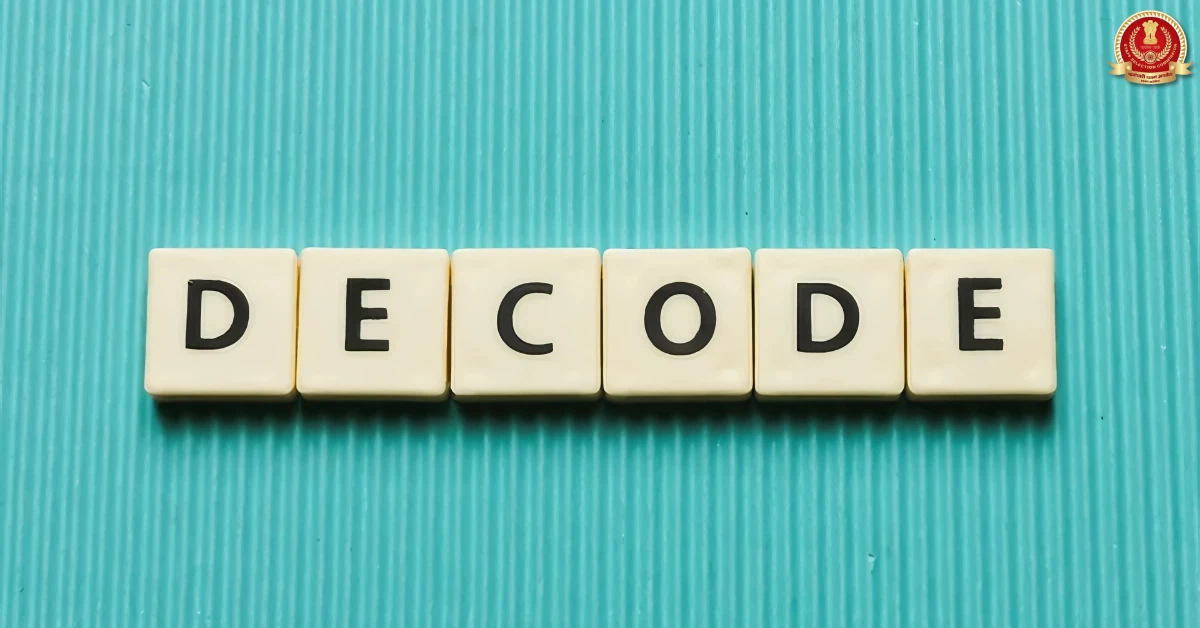Coding Decoding: In this blog, we are going to help you with an important question type of SSC CGL Reasoning Syllabus which is Coding-Decoding. In this blog, we will be explaining Coding-Decoding and also tips to solve the questions along with a few practice questions.
SSC CGL Reasoning Questions – Coding Decoding
Coding-Decoding is an important topic in the SSC CGL Reasoning section. These questions test your ability to identify patterns and logic behind coded messages. Regular practice can help improve speed and accuracy in this scoring area.
What is Coding Decoding?
Coding-Decoding is a common topic in the reasoning section of exams like SSC CGL. In this type of question, a word or number is written in a coded form using a specific pattern or logic. The goal is to understand the rule used in the code and apply it to find the correct answer.
Types of Coding-Decoding
Coding-decoding questions are asked in different forms. Each type follows a specific logic. Understanding these types will help you solve them quickly and accurately in the exam. The various types of coding and decoding are as follows:
- Coding using letters
- Number Coding
- Coding by substitution
- Mixed letter coding
- Mixed number coding etc
1. Coding Using Letters
In this type, each letter of the word is replaced with another letter based on a certain pattern.
Common Patterns Used:
• Shifting letters forward or backward in the alphabet
• Replacing letters with those at fixed positions (like A = Z, B = Y, etc.)
• Skipping letters in a fixed sequence
Example:
If the word DOG is coded as EPH, then each letter is shifted one step forward (D → E, O → P, G → H).
2. Number Coding
In number coding, letters of a word are replaced with numbers based on their position in the alphabet or other number patterns.
Common Patterns:
• A = 1, B = 2, …, Z = 26
• Total of positions of letters
• Reverse alphabetical order (A = 26, B = 25, etc.)
Example:
If CAT is coded as 3 1 20, then each letter is replaced by its position in the alphabet.
3. Coding by Substitution
In this type, words are replaced by unrelated words. You need to understand the substitution pattern based on the question.
Example:
If ‘pen’ is called ‘book’, ‘book’ is called ‘paper’, and ‘paper’ is called ‘pencil’,
then what do we write with? → Answer: Book (since ‘pen’ is called ‘book’)
4. Mixed Letter Coding
Here, 3–4 sentences are given along with their codes. You are asked to find the code for a specific word that appears in one or more sentences.
Approach:
• Compare sentences and codes
• Identify common words and their codes
• Use elimination to find the required code
Example Structure:
Sentence 1: “Birds fly high” → Code: ja pa ra
Sentence 2: “Birds sing well” → Code: pa ta la
Now, compare to find the code for “Birds”.
Attempt Previous Year Papers for Govt Exams
5. Mixed Number Coding
In this type, multiple sentences are given, each coded with a set of numbers. You need to match the numbers to the words by comparing all sentences.
Approach:
• Identify common words in the sentences
• Compare the number sets
• Eliminate non-matching codes
Example Structure:
Sentence 1: “Sky is blue” → 45 62 19
Sentence 2: “Blue is calm” → 19 73 62
From this, “blue” is common and appears with code 19 in both.
Tips to Solve Coding Decoding Questions SSC Exams
To solve Coding-Decoding questions accurately in SSC exams, it’s important to understand the alphabet positions, patterns, and tricks used in coding. Here are some useful tips:
1. Know Alphabet Positions (A to Z)
Learn the position of each letter in the English alphabet:
A = 1, B = 2, C = 3, …, Z = 26
Tip to Remember: Use the shortcut word EJOTY
• E = 5
• J = 10
• O = 15
• T = 20
• Y = 25
These help you quickly estimate the position of nearby letters.
2. Know Reverse Alphabet Positions (Z to A)
Sometimes letters are coded based on their position from the end.
Z = 1, Y = 2, …, A = 26
Example: B = 2 (normal), but in reverse order, B = 25
3. Know Opposite Letter Pairs
In some coding patterns, letters are replaced by their opposite letters in the alphabet.
Opposite Letter Pairs:
• A ↔ Z
• B ↔ Y
• C ↔ X
• D ↔ W
… and so on
Tip: The position of opposite letters always adds up to 27
(e.g., A=1 and Z=26 → 1+26=27)
4. Look for Common Patterns
Check whether letters are shifted forward or backward, skipped, or converted to numbers. Always compare examples provided in the question.
5. Practice Mixed Coding Types
Be ready to handle questions where substitution, letter shifting, or number patterns are mixed. Practice comparing sentences to find common codes.
30 Coding‑Decoding Questions for SSC Exams
Practice these questions carefully selected Coding‑Decoding questions for SSC CGL, SSC CHSL, SSC MTS and other SSC exams. The set begins with basic patterns and grows more challenging every five questions, helping you master all common coding techniques.
Q1.
In a certain code, CAT is written as DBU. How is DOG written?
A) EPH
B) EOI
C) EPH
D) EOI
Correct Answer: A
Q2.
If WORD is coded as XQTF, then TIME is coded as:
A) VJNG
B) UJNF
C) VJNF
D) UJNG
Correct Answer: C
Q3
In a code, each letter is replaced by the next but one letter. HELP becomes:
A) JGNQ
B) IGNQ
C) JGOQ
D) IGNQ
Correct Answer: A
Q4.
If BOOK is coded as FQTP, what is the code for PEN?
A) RJQ
B) RKR
C) RJO
D) RKR
Correct Answer: A
Q5.
In a code language, FIND → GJOF. How will CODE be written?
A) DPEG
B) DPDF
C) DPDF
D) DPEG
Correct Answer: A
Q6.
Letters in a word are reversed and then each letter is shifted one forward. HELLO becomes:
A) PMMFI
B) OMMFI
C) OMMGJ
D) PMMGJ
Correct Answer: B
Q7.
In a code, vowels are replaced by next vowel and consonants by previous consonant. JUMP → ?
A) KILN
B) KILN
C) ITLN
D) ITLO
Correct Answer: A
Q8.
If ABCDE → ZABCD, then LMNOP → ?
A) KLNMO
B) KLMNO
C) KLNMO
D) KLMNO
Correct Answer: D
Q9.
A word is coded by writing alternate letters first, then the rest. BOARD → ?
A) BOARD
B) BRDAO
C) BADOR
D) BDARO
Correct Answer: B
Q10.
In a code, each letter is assigned its position in reverse alphabet (A=26). What is the code for ACE?
A) 26‑24‑22
B) 26‑24‑23
C) 26‑25‑23
D) 26‑24‑22
Correct Answer: D
Q11.
“RAT” is coded as “XZG”. Which rule is applied?
A) +2, +2, –2
B) –2, +2, –2
C) +2, –2, +2
D) –2, –2, +2
Correct Answer: A
Q12.
If GOLF → TOLU, then PLAY → ?
A) KOBI
B) KOBX
C) KOBX
D) KOBI
Correct Answer: B
Q13.
In a code, each pair of letters is swapped and shifted one forward. MARCH → ?
A) NBQDI
B) NBDQI
C) NBDQI
D) NBQDI
Correct Answer: B
Q14.
If PLANT is coded as QMBOS, how is WATER coded?
A) XBUFS
B) XBUFS
C) YCVGT
D) XCVFS
Correct Answer: A
Q15.
A word is coded as the sum of the positions of its letters. What is the code for BAD?
A) 7
B) 6
C) 5
D) 8
Correct Answer: A
Q16.
In a mixed code, letter positions are reversed and then shifted two forward. BANK → ?
A) YCPM
B) YCPM
C) YCPN
D) ZCPM
Correct Answer: A
Q17.
If ALPHA → ZKOWZ, then DELTA → ?
A) WCJAZ
B) WCJAZ
C) WCJZG
D) WDJZG
Correct Answer: A
Q18.
Each letter is replaced by the letter three places ahead in reverse order. CODE → ?
A) XLAW
B) XLAW
C) XMAW
D) XLAU
Correct Answer: A
Q19.
In a code, consonants shift two forward and vowels two backward. CAMP → ?
A) ECOR
B) ECOR
C) ECQR
D) ECOM
Correct Answer: A
Q20.
If TRICK → UQHBL, what rule is used?
A) +1, –2 alternating
B) +1, +2 alternating
C) –1, +2 alternating
D) +1, –2, +3…
Correct Answer: A
Q21.
In a sentence coding, “THE SKY IS BLUE” → “UXF VLA KU BMFH”. What is code for “SKY”?
A) VLA
B) ULA
C) VLB
D) ULB
Correct Answer: A
Q22.
If EAGLE → HFJMG, then BIRD → ?
A) DOGF
B) DNGF
C) DNGF
D) DOGE
Correct Answer: B
Q23.
Letters are replaced by those 4 steps ahead and number of vowels appended. TEST → ?
A) XIWX2
B) XIWX2
C) XIWY2
D) XIWX1
Correct Answer: A
Q24.
In a code, each letter is replaced by its opposite (A↔Z) then shifted one forward. HELLO → ?
A) UFMMP
B) TFNNO
C) TFNNO
D) UGMMQ
Correct Answer: B
Q25.
A word is coded by writing its letters’ square of positions. BAD → ?
A) 1‑4‑1
B) 4‑1‑4
C) 1‑2‑4
D) 4‑1‑4
Correct Answer: D
Q26.
Each letter moves to the letter two places to its left in a circular alphabet. QUIZ → ?
A) OSGX
B) OSGY
C) OSGX
D) OSFY
Correct Answer: A
Q27.
If odd‑position letters shift +3 and even‑position letters shift –2. MARCH → ?
A) PBQFJ
B) PBQFJ
C) PBQFJ
D) PBQGJ
Correct Answer: A
Q28.
In numeric coding, letter = (position)². What is CAT?
A) 9‑1‑400
B) 3‑1‑20
C) 9‑1‑20
D) 9‑1‑400
Correct Answer: D
Q29.
A code writes consonants in reverse order and vowels normally. QUERY → ?
A) VRWQV
B) VPRQV
C) VPRQY
D) VPRQV
Correct Answer: D
Q30.
Each letter is replaced by the one two steps ahead in forward and one step back in reverse alternately. SHIFT → ?
A) UIJGW
B) UHJGV
C) UIGJW
D) UIJHV
Correct Answer: A
Check out Courses for All Govt Exams
Coding Decoding for SSC Exams FAQs
Ans: It is a scoring topic that checks your logic and pattern recognition. It appears regularly in SSC CGL, CHSL, and MTS exams.
Ans: Letters are replaced by their positions in the alphabet (A=1, B=2, etc.), or by reverse positions (Z=1, Y=2, etc.).
Ans: Use the EJOTY trick:
E=5, J=10, O=15, T=20, Y=25 — helps you estimate letter positions quickly.
Ans: Not if you’re well-practiced. These questions become quick to solve once you’re familiar with standard patterns.
Ans: A ↔ Z, B ↔ Y, C ↔ X, etc. Their positions always add up to 27 (e.g., A=1, Z=26 → 1+26=27).
- SSC CGL 2025 Tier 1 Question Papers, Shift-Wise PYPs, Download PDFs
- Delhi Police Vacancy 2025, Check Exam wise vacancies
- SSC CGL Tier 2 Study Plan 2025 for Last 15 Days Before Exam
- Delhi Police HCM Exam Date 2025 Out, CBT scheduled from 7th to 12th January 2026
- Most Repeated Quantitative Aptitude Questions for SSC CHSL Tier 2
- Most Repeated Reasoning Questions For SSC CHSL Tier 2, Download PDF
Hello, I’m a content writer working at Oliveboard. I focus on creating blogs, articles, and educational content that’s simple, clear, and saves time for readers. I believe in writing that adds real value without overcomplicating things. I also have strong knowledge of banking and government exams, which helps me create content that is both accurate and easy to understand. With experience and consistency, I aim to make preparation smoother for every learner.

